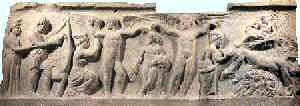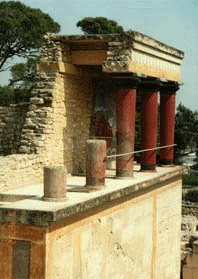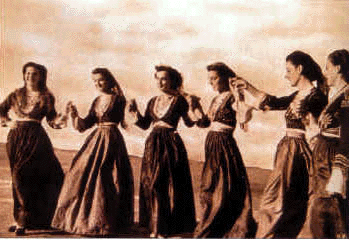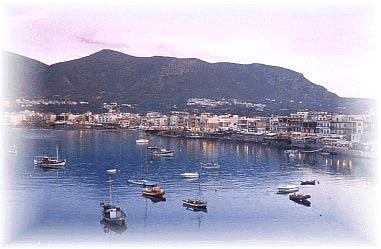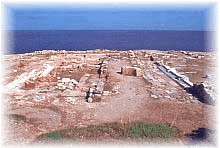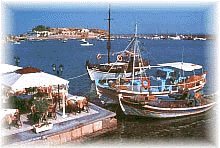Why Crete? [English]
Crete
History
Famous
Cretans
What is
special about the island?
Chersonissos
Crete
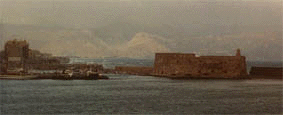
A few words about the island of Crete.
| Crowning the southern-most part of the Aegean, Crete has been standing there for centuries, proud bearer of its past; a past that blends myth and historical fact, power and demise, leadership and defeat, but never subjugation, never weakness. Its terrain unpredictable... filled with mountain ranges, intense and defying, serene plateaus - blessed with the rich vegetation that only gods could bestow on this island - interspersed with wide expanses of serene valleys and gentle hills, that meet the waters of the sea, some times with fierce determination, others with quiet resolve. The island of King Minos and a civilization that left its mark on the world, faced the voracious appetite of conquerors from mainland Greece, Rome, Byzantium, the Ottoman Empire, the Venetians, was raided by pirates and invaded by armies who cruised the Mediterranean in search of riches and power. The proof of this in every corner of the land; in Chania, Rethymno, Iraklio, Lassithi. Finds of long-forgotten civilizations, castles with thick walls and deep moats, monasteries and churches, standing along-side minarets and mosques, they are all testaments to the turbulent past of this corner of Greece. And the people!!!... Proud as the mountains, strong as the waves that beat upon its shores, yet gentle and generous, bearers of age-old traditions and culture. This is the birthplace of gods and heroes, divine artists and inspired politicians: Zeus and Minos, El Greco, Kornaros, Kazantzakis, Venizelos ... From myth, to antiquity, to renaissance, to modern Greek history, figures who contributed of themselves to what today makes up Crete, Greece and to some extend Western civilization. |
Map

Photos
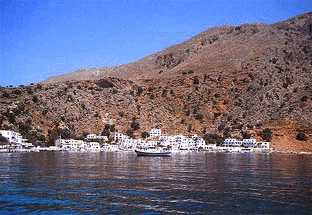
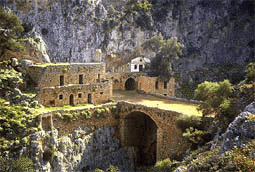
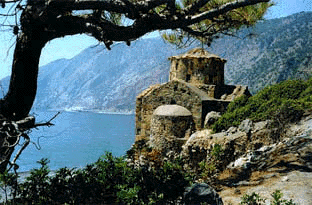
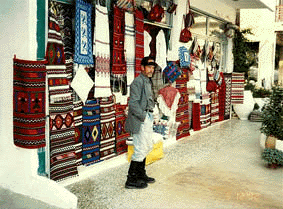
History
Cretan Civilization
| The most brilliant Aegean island civilization was the Cretan or Minoan civilization which flourished in Crete mainly in the 3rd and 2nd millennia B C. and took its name from the legendary king of Knossos, Minos, In 1450 B.C Crete had become a mighty sea power and had amassed great riches and treasures which allowed it to build, between 2200 and 1550 B.C. the renowned Cretan palaces of Knossos and Phaestos where the arts flourished. The Cretans taught the art of seamanship to the Phoenicians and the Greeks. They imposed themselves in the Cyclades and in Attica and exercised great influence over Mycenae and Tiryns. It is said that the Cretan kings granted "protection", on payment of a fee, to various other cities, as one gathers from certain myths and particularly the legend of Theseus. They also developed trade with Egypt and set up colonies in Cythera and later in Miletus. In 1893, the archaeologist Arthur Evans brought to light almost the entire Minoan civilization. The excavations uncovered a bright and colorful world. The frescoes not only in the palaces but In humble dwellings as well bear witness to the gay character of the Cretans, their love for life, for nature, for fun and dancing. A peaceful people, it is said they had concluded a "Pax Minoica" with their neighbors. Their art is marked by colour, movement and liveliness. It shows scenes of religious processions, games and bullfights as well as themes from the world of plants and the sea. Their technical knowledge is to be admired even today. Their script was hieroglyphic. The value of the Minoan civilization is very great. it was the first true civilization in Europe and formed the basis for the later, brilliant, Greek civilization, the Mycenaean. It disappeared at the end of 1500 B C. after the volcanic eruption of Thera which, according to one view, also caused the destruction of Crete. It was a chronological milestone, since from that date onwards the techniques and aesthetics of mainland Greece prevailed over the entire Aegean and in Crete. |
Myths of Crete
- ARIADNE & THESEUS
Minotaur lived of human blood and King Minos had ordered the city of Athens, that blaimed for his son's Androgeos death, to offer young boys and girls as food for the supernatural creature. Among them was Theseus, the son of King Aegeas, whose mission was to kill Minotaur and releaved his country from this "blood tax". To his aid came Ariadne, the daughter of King Minos, who was in love with him and offered her help; in return, Theseus would have to marry her and take her home to Athens. Thus, Theseus succeeded in his mission by killing the Minotaur and coming out of the labyrinth wrapping the "Mitos of Ariadne", a ball of thread he had unwrapped when entering the maze. According to myth, Theseus after being united with Ariadne at the islet of Zeus and having two children with her, deserted her. According to mythology, he left her because he was in love with Egli. Another theory is that goddess Athena asked him todo so and yet another one is that god Dionysus fell in love with Ariadne. It is said that Ariadne is the impersonation of the goddess of vegetation, dying and being born again, every year. Theseus' return had an unfortunate ending, as the young hero forgot to take the black sail off the boat as he had promised his father, Aegea. The latter, thinking that the Minotaur had won and killed Theseus, committed suicide by drawing in the Aegean Sea.
- BIRTH OF ZEUS
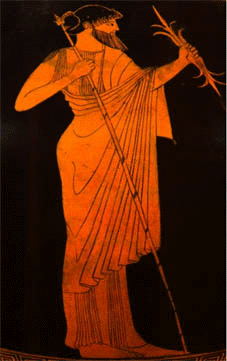
According to mythology, Zeus, the God of gods, was born in Crete. Cronus, his father, trying to avoid his parents' curse that one of his children would take away from him the ruling of the sky, murdered his children one-by-one, by eating them. His wife, Rhea, terrified and chased by her husband, sought refuge in a cave in the ancient "Aegean Mountain", and, with the help of Uranus and Gaia, gave birth to her last child. Cronus was fooled with a rock in dipers and the loud singing and dancing of demons "Kourites", covering the noise of the newborn's cry. Zeus was rased by the Nymphs, drinking milk from goat Amalthia, the later became a star and her skin was Zeus' shield. When Zeus grew up, he defeated Cronus and became the ruler of the sky. The rock that had fooled his father was put in Delfphi, to remind mortals and gods of his glorious power.
- DAEDALUS & IKARUS
- MINOS' REIGN
One of Zeus and Europe's sons was King Minos. Minos replaced Asterios, the fromer King of Crete and husband of Europe, and became one of the most powerful rulers of the island, ever. "Minos" was probably a royal title symbolising the power and authority of a great ruler, judge and representative of the gods. The Kingdom of Minos united all the Cretan cities, the biggest being Knossos and Phaestos, and became a great naval power with tremendous cultural and economic development. The Kingdom was divided in three parts, the first including Knossos, the second including Phaestos and the third including Cydonia. The minoan civilization spread and influenced throughout the Eastern Mediterranean Sea, created new cities and progressed in art and literature. Life was based upon strict and fair rules that Zeus indicated to his son, or so is said. Minos legislation was so fair, that he was later appointed superior judge in Ades, judging the sins of the dead. Minos' assistant in administation was his brother Radamanthys, who was equally good at ruling and judging people.
- PASIPHAE & MINOTAUR
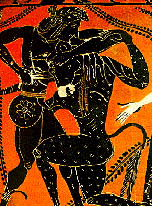
Minos bewed Pasiphae, the daughter of Sun and nymph Crete and together had eight children, Androgeos, Katreas, Glafkos, Dafkalion, Ariadne, Xenodiki, Akalli and Phaedra. According to mythology, when Minos asked Neptune for a sign that would mean he would become the King of Crete, from the sea emerged a beautiful bull that Minos refused to sacrifice, thus irritating Neptune who punished Minos by making his wife Pasiphae fall in love with the white bull. Pasiphae, with the help of a wooden cow made by Daedalus, was united with the bull and gave birth to Minotaur, who had the body of a human and the head of a bull. According to myth, this creature lived in the Labyrinth, in the palace's underground and was fed with the blood of youngsters. The famous Athenean hero Theseus defeated Minotaur and releaved Athens from the harsh "blood tax" that paid to this supernatural creature.
- TALOS
When Zeus was united with Europe, to show her his love he gave her three presents, one of which was the bronze giant Talos, created by Hephaestus. According to mythology, Talos was the son of Cris and father of Phaestos or, according to another version, he was Minos' brother. His duty was to travel around the island with his bronze slates with the laws and make sure that they were obeyed. He also protected Crete from the enemy, throwing rocks to the enemy ships or burning them with his hot bronze body. Despite his power, Talos didn't resist Media's promises for immortality, thus being framed and letting the ship of "Argo" pass by Crete without being destroyed. As he stood peacefully, Media stroke his weak vain and killed him, extracting the divine fluid that had inside him, instead of blood. According to another version, Talos died from the arrow of Pias, Philoctete's father.
- ZEUS & EUROPE
According to mythology, Zeus fell in love with princess Europe of Phoenicia. So, he turned into a white bull with firm body, golden horns and innocent eyes and tricked the princess and her friends who were peaking flowers. He brought Europe to Crete and, as tokens of his love, he gave to the girl: giant Talos to protect the island, a quiver of arrows that always succeeded in hitting their goal and a golden dog as her guardian angel. Mythology claims that Zeus and Europe were united in the area of Gortys, under a platan which became evergreen, or at Diktaion Andron where the nymphs had prepared the bridal bed. Zeus and Europe bore three sons: Radamanthys, Sarpedon and king Minos.
Knossos
| |||
|
The most important monuments of the site are: The Palace of Knossos. It is the largest of the preserved Minoan palatial centres. Four wings are arranged around a central courtyard, containing the royal quarters, workshops, shrines, storerooms, repositories, the throne room and banquet halls. Dated to 2000-1350 B.C. The Little Palace. It lies to the west of the main palace and has all the features of palatial architecture: scraped wall masonry, reception rooms, a pristyle hall, a double megaron with polythyra (pi er-and-door partitions) and a lustral basin-shrine. Dated to the 17th-15th centuries B.C. The Royal Villa. It lies to the NE of the palace and its architectural form is distinguished by the polythyra, the pillar crypt and the double staircase, with two flights of stairs. It is strongly religious in character and might have been the residence of an aristocrat or a high priest. Dated to the 14th century B.C. House of the Frescoes. It is located to the NW of the palace and is a small urban mansion with rich decoration on the walls. Dated to the 15th, 14th-12th centuries B.C. Caravanserai. It lies to the south of the palace and was interpreted as a reception hall and hospice. Some of the rooms are equipped with baths and decorated with wall paintings. The "Unexplored Mansion" Private building, probably of private-industrial function, to the NW of the palace. It is rectangular, with a central, four-pillared hall, corridors, storerooms and remains of a staircase. Dated to the 14th-12th centuries B.C. Temple Tomb. It is located almost 600 m. to the south of the palace and was connected with the "House of the High Priest" by means of a paved street. It seems that one of the last kings of Knossos (17th-14th centuries B.C.) was buried here. Typical features of its architecture are the hypostyle, two-pillar crypt, the entrance with the courtyard, the portico and a small anteroom. House of the High Priest. It lies 300 m. to the south of Caravanserai and contains a stone altar with two columns, framed by the bases of double axes. The South Mansion. Private civic house, located to the south of the palace. It is a three-storeyed building with a lustral basin and a hypostyle crypt, dating from the 17th-15th centuries B.C. Villa of Dionysos. Private, peristyle house of the Roman period. It is decorated with splendid mosaics by Apollinarius, depicting Dionysos. The house contains special rooms employed for the Dionysiac cult. Dated to the 2nd century A.D. | |||
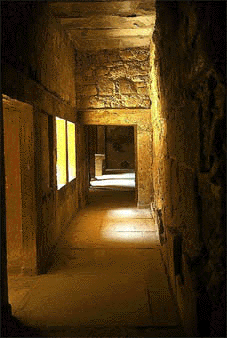 |
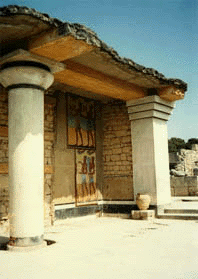 | ||
Historic Persons
- El Greco
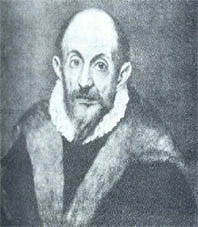
Domenicos Theotokopoulos was born in Heraklio, in 1541. He was first taught hagiography at a venetian workshop and was influenced by the Cretan Hagiographic School (16th century) and the byzantine art. He spent most of his life in Toledo, Spain, where he died in 1614. El Greco, as he was called, occupied with sculpture and architecture, although the only samples of his work are the sculpt icon- stands in Santo Domingo el Antiguo (1577), the chapel of San Jose in Toledo (1597-1599) and the church of Mercy Hospital in Ilieskas (1603 - 1605). El Greco's painting follows the four cities where he lived: Heraklio, Venice, Rome and Toledo. The most known of his work are: "Boy blowing the coal", "Holy Trinity", "St. John Baptist", "Mercyful Virgin Mary", "The "Ascention of Virgin Mary" and others.
- Vincenzos Kornaros
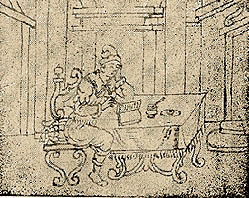
Although there is no definite information about Vicenzos Kornaros, it is known that he lived in Sitia and Heraklio in the 17th century and died in 1677. Kornaros is said to have written the famous cretan work of literature "Erotokritos". This terrifice narrative piece was written in 10,000 15-syllable verses. There is only one remaining copy, dated back in 1710. The work was first published in Venice, in 1713. Even though the plot is trivial, it is said that Kornaros was inspired by the french medieval play "Paris et Vienne", which he turned in a literal masterpiece. Kornaros is said to have written the poetic drama "Abraham's Sacrifice" which consisted of 1,154 15-syllable verses and was first published in 1635. His ideal was the tragedy "Isaac", by Italian L. Grotto.
- Eleftherios Venizelos
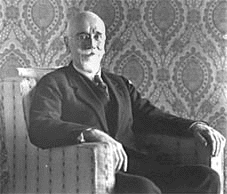
Eleftherios Venizelos was born in Chania, in 1864. His family came from Sparti and came to the island when Benizelo Krevatas moved here in 1790 and gave his name to the famous family of Venizelos. Eleftherios had a difficult childhood, as the revolution forced his father to leave the island and move to Syros, where the young boy had his first education. After a PhD in Law, he left Athens in 1886 to return to his home-town. He soon was involved in politics and was elected congressman at the Cretan Council; he later became Minister of Justice. In 1905 he was the leader of United Opposition Party, while in 1908 he was again appointed Minister of Justice and Foreign Affairs. After his intervention in the negotiations between the "rebels", the Crown and the Political Parties, he was elected "President of the Greek Council of the Cretans" and Prime Minister of Crete, in 1910. Within the next months he became the leader of the Liberal Party, won the elections of the Revisory Parliament (December 1910) and thrived at the next elections (March 1912). In 1916, he established at Chania - along with Daglis and Koundouriotis - the National Triumvirate, forming a temporary government of National Defence. He lost the elections of 1920 and went abroad. In 1923, Venizelos represented Greece at the Treaty of Lozanne, signing the treaty of exchanging populations. Later in that year, he came back to Greece and became governor, only to quit within a short period of time. In the following years, Venizelos was on and off the government until he lost the elections of 1933. Later that year, someone attempted to murder him at Kifissias Ave. Venizelos died in Paris, in March 1936. He was buried at Akrotiri Chanion.
- Nikolaos Kazantzakis
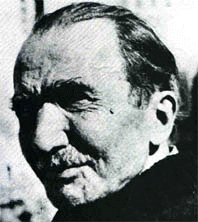
One of the most significant Greek novelists, poets, drama writers and scholars. He was born in Heraklio, in 1833 and studied Law in Athens and Philosophy in Paris. He was influenced by the theories of Ion Dragoumis and Eleftherios Venizelos. His trip to Russia in 1919, acting as General Manager of the Ministry of Welfare, was the introduction of his exciting odyssey: Vienna, Berlin, Italy, Crete, Russia, Cyprus, Spain, Egypt, mount Sinah, Goethesgub (Tsechoslovakia), Nice (France). He died in Germany, in 1957. His first novel was "The Snake and the Lilly", in 1906, followed by "Foreman", "Ascetic Life", the translation of Dante's "Divina Comedy". His prime was evident by the works "Life of Alexis Zorbas", "Christ is crossed again", "Captain Michael", "The Last Temptation", "God's Poor Man" and "Reference to Greco".
What is special about the island?
People
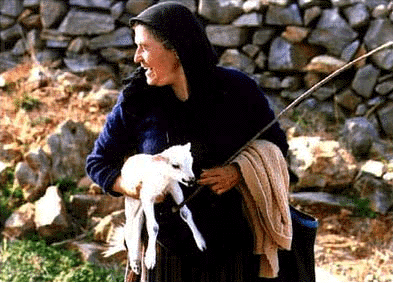 |
|
Traditional Songs
The cretan music tradition has had many influencies and is very different from others. The first samples are "Pirichii", war songs sung by giants Kourites, while, in the first post-christian century, song writer Messodemos lived and wrote cretan music. The most famous cretan songs are "mantinades", songs accompanied by lyre and lute. The singer adjusts the lyrics to the circumstance, and mantinades vary from love songs to satirical, historical, or social content songs. The rhymesters compete with each other for the best, most succesful verse which will be greeted with great enthousiasm from the audience. Another important category of cretan songs includes the historic songs which narrate facts from the islandΥs disorderly history, praising the cretan heroism and willingness to fight. Among the regional songs are the "rizitika", sung in western Crete. They are thus called, because they originate from the foot or "roots" (rizes) of Lefka Ori. There are two types of rizitika: the "table" songs (tragoudia tis tavlas), sung without music instruments at feasts and dinner parties, and the "songs of the road" (tragoudia tis stratas), sung by travellers along the way. Unlike mantinades, rizitika are not improvised, expressing an emotional state, but they are the result of a long tradition, ever since the ancient years.
Traditional Instruments
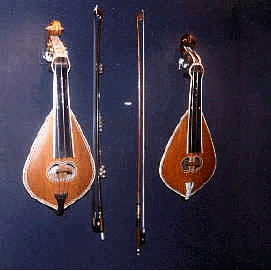 |
|
Folk Dances
|
|
|
Traditional Cuisine
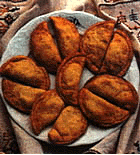 |
|
Folk Art
Basket-Weaving
In Crete, basket-weaving is part of the local folk tradition. Agricultural work forced the Cretans to develop the craft of basket- weaving, in order to make their rural and domestic chores easier. The secrets of basket- weaving are taught from the old craftsmen to the young ones. Utilising material from the cretan flora, such as reed, osier and splinter, basket-weavers create original and pretty designs which can be admired throughout Crete.
Ceramics
Rural and domestic chores forced the Cretans to make clay jars and pots. The cretan jags, made of hard material, are known for their original beautiful design and their resistance to high temperature. As years progressed, pottery evolved and small items, flower pots, jars and decorative ornaments were created. The most important pottery centers are Margarites in Rethymno and Kentri in Ierapetra. The best -known pottery centre, however, is Thrapsano in Heraklio. Here, one can find ceramics for every possible use.
Knifemaking
Cutlery is part of the cretan folk tradition. The islandΥs disorderly history forced the locals to fight for their freedom and be constantly armed. Today, the knife tied around the waist is only part of the traditional cretan costume. The craft of cutlery is taught from one generation to the next, with the elderly teaching the youngsters how to make and decorate knives. The majority of the cretan knives have elegant designs, curved on the handle which is made of silver or animal horn. The sharpened steel blade, for safety reasons, is put into a cup made of wood, leather or silver. A knife with a "mantinada" curved on its handle, is a beautiful souvenir from Crete.
Traditional Textiles
Cretan women are known for their skill in weaving, as in other crafts. The old traditional cretan houses were characterised by the loom - vertical or upright - where women spent a large part of their day. It was the place where they made the daily clothing of the family, blankets, towels, rugs, aprons and tablecloths. Although less women are occupied with weaving, today one can still purchase the famous cretan woven fabrics,unique samples of fok art, in beautiful colours and original designs. Many families are occupied entirely with weaving, from breeding stocks to weaving wool. The materials used are flax, cotton and silk which are dyed red from the weavers themselves, who gather for this purpose and teach their craft to the younger ones.
Wood Sculpture
The old wood-curving produced items of religious art: icons, icon-stands, pulpits, candlesticks and other objects of eastern influence, still decorating churches. Today, only few wood-carvers are still to be found, mainly constructing folk musical instruments. However, in several mountainous regions, talented amateurs create small works of art (spoons, forks, wooden stamps for impressive designs, lyres and various other objects).
|
Info Access |
|
|
|
|

